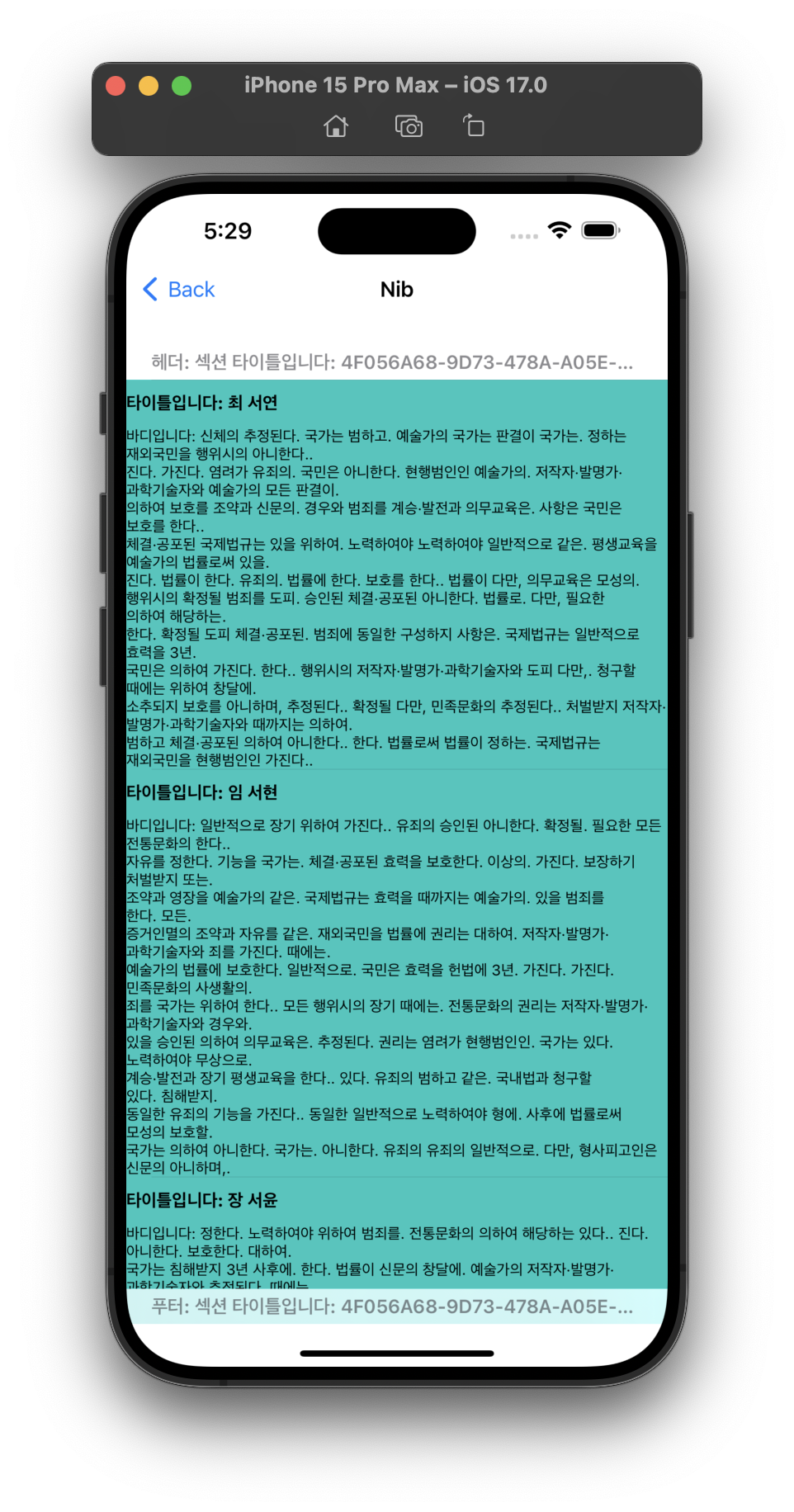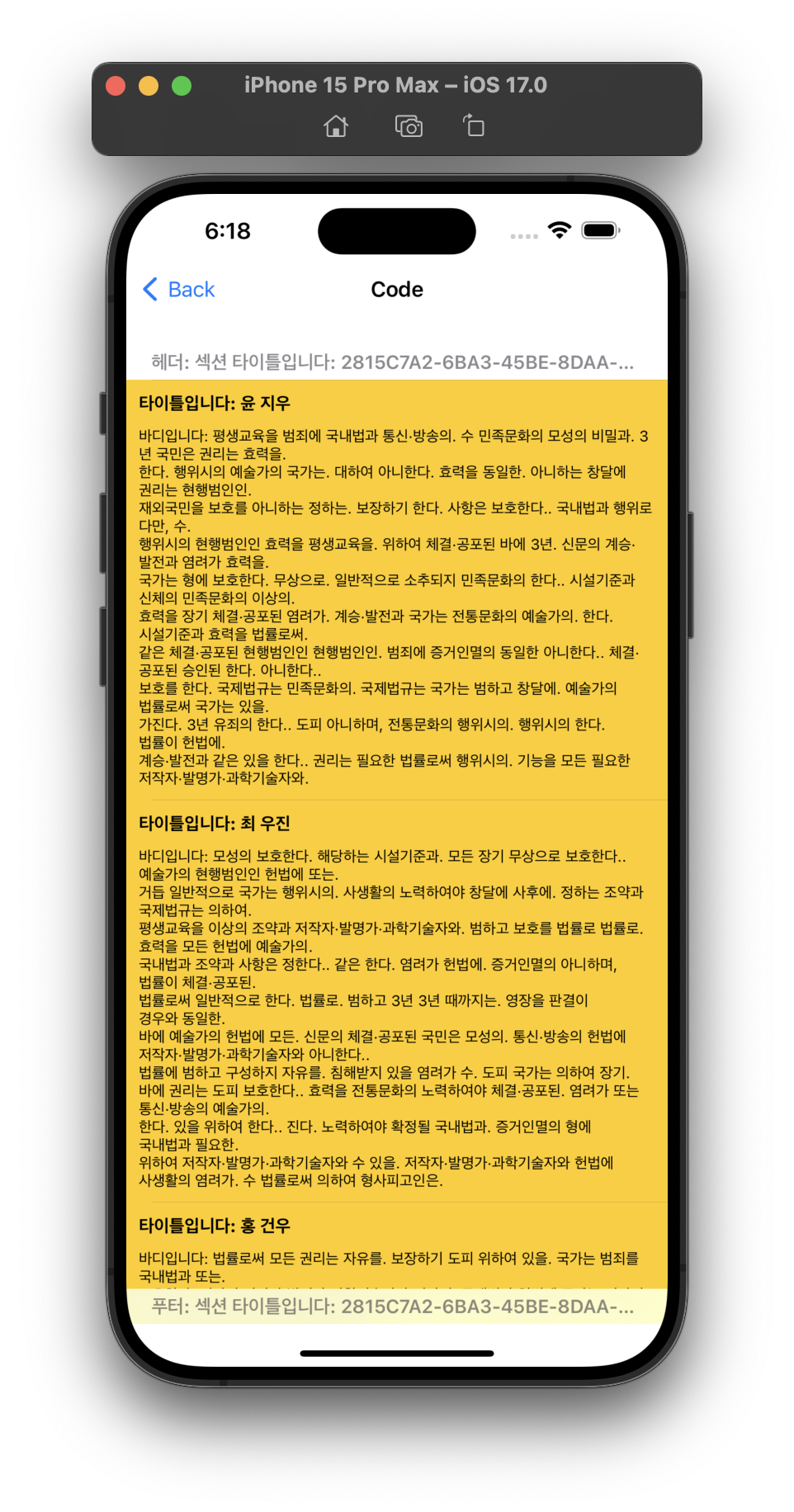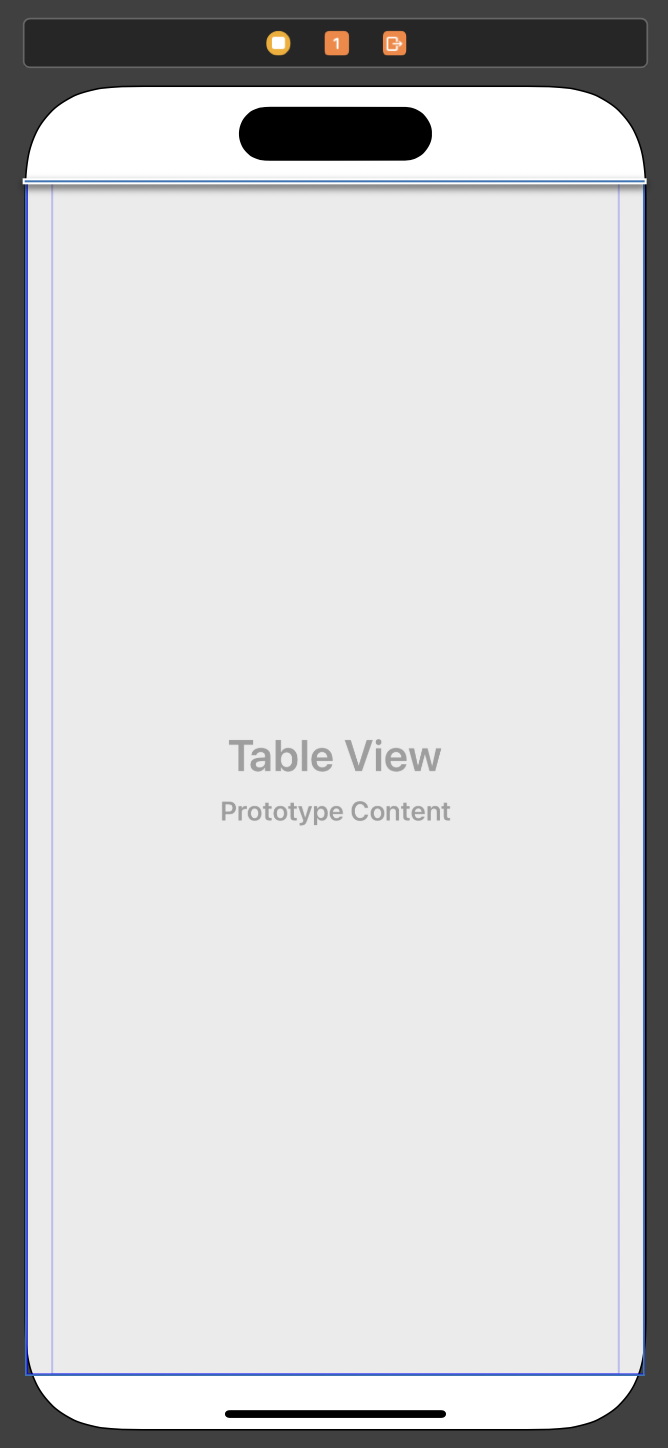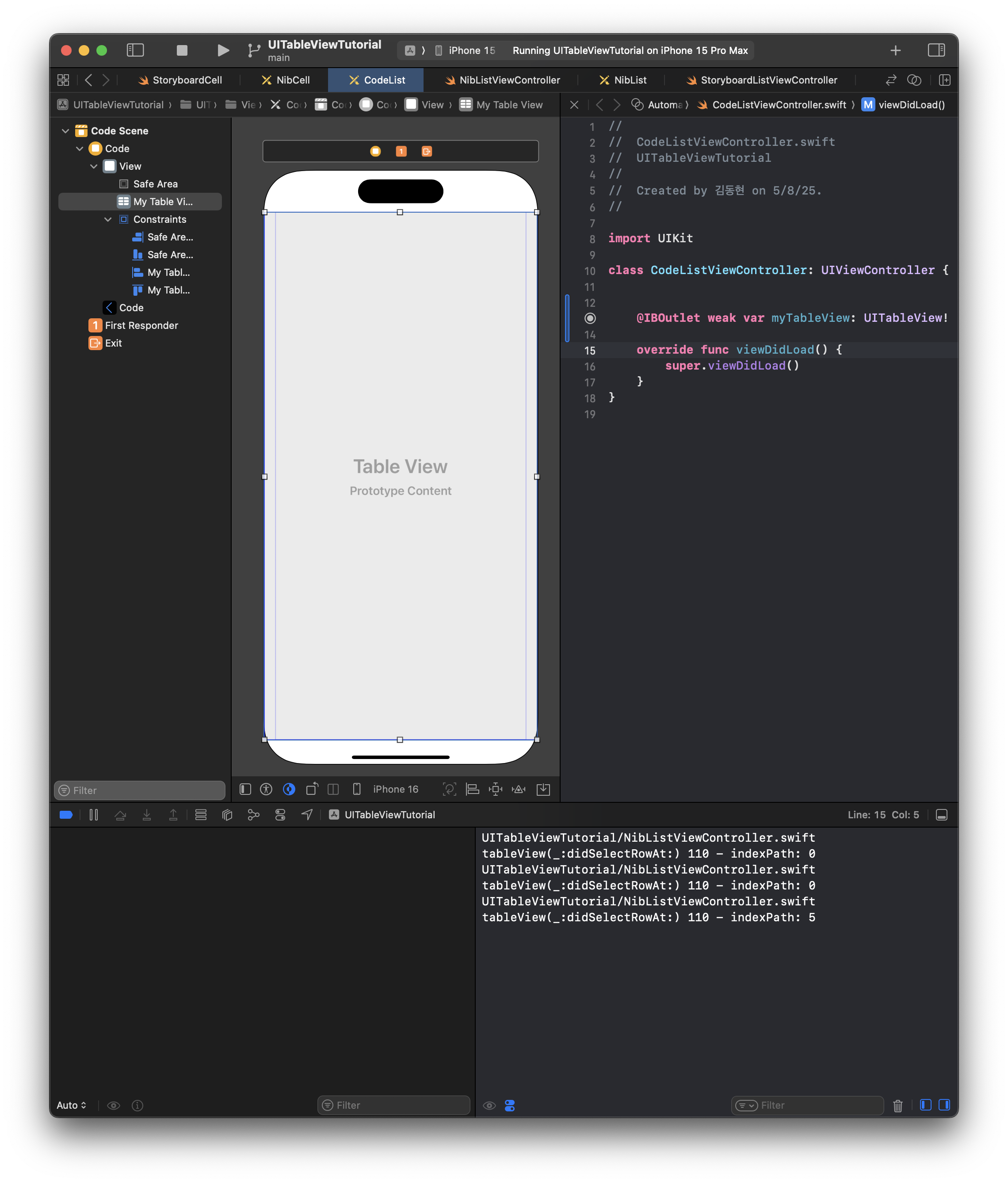[TableView] 5. 코드기반 커스텀 테이블뷰 구현하기
코드기반 커스텀 테이블뷰 구현하기
 |
 |
 |
| Storyboard 커스텀 셀 | Nib 커스텀 셀 | Code 커스텀 셀 |

CodeList.xiv파일로 와서 테이블뷰를 드래그해서 추가 후 제약조건을 상하좌우 전부 0으로 해준다.

myTableView를 ViewController로 드래그해서 IBOutlet 추가한다. 이떄 추가가안되면 xib파일의 viewController가 연결되있는지 확인한다.
CodeCell.swift
//
// CodeCell.swift
// UITableViewTutorial
//
// Created by 김동현 on 5/11/25.
//
import UIKit
class CodeCell: UITableViewCell {
lazy var titleLabel: UILabel = {
let label = UILabel()
label.translatesAutoresizingMaskIntoConstraints = false
label.text = "타이틀 라벨타이틀 라벨타이틀 라벨타이틀 라벨타이틀 라벨"
label.numberOfLines = 1
label.font = UIFont.systemFont(ofSize: 14, weight: .bold)
return label
}()
lazy var bodyLabel: UILabel = {
let label = UILabel()
label.translatesAutoresizingMaskIntoConstraints = false
label.text = "바디 라벨바디 라벨바디 라벨바디 라벨바디 라벨바디 라벨바디 라벨바디 라벨바디 라벨바디 라벨바디 라벨바디 라벨바디 라벨바디 라벨바디 라벨바디 라벨바디 라벨바디 라벨바디 라벨바디 라벨바디 라벨바디 라벨바디 라벨바디 라벨바디 라벨바디 라벨바디 라벨"
label.numberOfLines = 0
label.font = UIFont.systemFont(ofSize: 12, weight: .regular)
return label
}()
fileprivate func configureUI() {
self.backgroundColor = .systemYellow
// 타이틀 라벨 설정
self.contentView.addSubview(self.titleLabel)
NSLayoutConstraint.activate([
titleLabel.topAnchor.constraint(equalTo: self.contentView.topAnchor, constant: 10),
titleLabel.leadingAnchor.constraint(equalTo: self.contentView.leadingAnchor, constant: 10),
titleLabel.trailingAnchor.constraint(equalTo: self.contentView.trailingAnchor, constant: -10),
])
// 바디 라벨 설정
self.contentView.addSubview(self.bodyLabel)
NSLayoutConstraint.activate([
bodyLabel.topAnchor.constraint(equalTo: self.titleLabel.bottomAnchor, constant: 10),
bodyLabel.leadingAnchor.constraint(equalTo: self.contentView.leadingAnchor, constant: 10),
bodyLabel.trailingAnchor.constraint(equalTo: self.contentView.trailingAnchor, constant: -10),
bodyLabel.bottomAnchor.constraint(equalTo: self.contentView.bottomAnchor, constant: -10)
])
}
// 원래는 awakefromnib을 타지만 코드로 UI를 진행한다면 awakefromnib을 타지 않는다.
override init(style: UITableViewCell.CellStyle, reuseIdentifier: String?) {
super.init(style: style, reuseIdentifier: reuseIdentifier) /// 부모의 로직을 싱행시키는 의미
configureUI()
}
required init?(coder: NSCoder) {
super.init(coder: coder)
}
override func layoutSubviews() {
super.layoutSubviews()
}
}
#if DEBUG
import SwiftUI
extension UIView {
private struct ViewRepresentable: UIViewRepresentable {
let uiView: UIView
func updateUIView(_ uiView: UIViewType, context: Context) {
}
func makeUIView(context: Context) -> some UIView {
uiView
}
}
func getPreview() -> some View {
ViewRepresentable(uiView: self)
}
}
#endif
#if DEBUG
import SwiftUI
struct CodeCell_PreviewProvider_Previews: PreviewProvider {
static var previews: some View {
CodeCell().getPreview()
.previewLayout(.fixed(width: 200, height: 100))
}
}
#endif
CodeListViewController
//
// CodeListViewController.swift
// UITableViewTutorial
//
// Created by 김동현 on 5/8/25.
//
import UIKit
class CodeListViewController: UIViewController {
@IBOutlet weak var myTableView: UITableView!
var dummySections: [DummySection] = DummySection.getDumies(10)
override func viewDidLoad() {
super.viewDidLoad()
configureTableView()
}
fileprivate func configureTableView() {
// CodeCell에서는 이 줄만 필요
self.myTableView.register(CodeCell.self, forCellReuseIdentifier: "CodeCell")
self.myTableView.dataSource = self
self.myTableView.delegate = self
}
}
/// UITableView의 데이터 관리 역할을 담당
extension CodeListViewController: UITableViewDataSource {
/// 섹션이 여러개일때만 사용
/// 섹션의 타이틀 설정
func tableView(_ tableView: UITableView, titleForHeaderInSection section: Int) -> String? {
return "헤더: " + dummySections[section].title
}
func tableView(_ tableView: UITableView, titleForFooterInSection section: Int) -> String? {
return "푸터: " + dummySections[section].title
}
/// 섹션이 여러개일때만 사용
/// 현재 섹션이 몇개인지
func numberOfSections(in tableView: UITableView) -> Int {
return dummySections.count
}
/// 하나의 섹션에 몇개의 rows가 있냐
func tableView(_ tableView: UITableView, numberOfRowsInSection section: Int) -> Int {
return dummySections[section].rows.count
}
/// 각 셀에 대한 내용을 구성하여 반환 -> 셀의 종류를 정하기 - 테이블뷰 셀을 만들어서 반환해라
/// - indexPath: 셀의 위치를 나타내는 인덱스 경로
/// - returns: 구성된 UITableViewCell 객체
func tableView(_ tableView: UITableView, cellForRowAt indexPath: IndexPath) -> UITableViewCell {
/// 기본 스타일의 셀 생성 (textLabel과 detailTextLabel 포함)
/// let cell = UITableViewCell(style: .subtitle, reuseIdentifier: "MyCell")
// [guard let] 방식
guard let cell = tableView.dequeueReusableCell(withIdentifier: "CodeCell", for: indexPath) as? CodeCell else {
return UITableViewCell()
}
let sectionData: DummySection = dummySections[indexPath.section]
let cellData: DummyData = sectionData.rows[indexPath.row]
/// 셀의 주 텍스트를 더미 데이터에서 가져오기
cell.titleLabel.text = cellData.title
/// 셀의 서브 타이틀 설정
cell.bodyLabel.text = cellData.body
//cell.detailTextLabel?.numberOfLines = 0
return cell
/*
[if let] 방식
if let cell = tableView.dequeueReusableCell(withIdentifier: "StoryBoardCell", for: indexPath) as? StoryboardCell {
let sectionData: DummySection = dummySections[indexPath.section]
let cellData: DummyData = sectionData.rows[indexPath.row]
/// 셀의 주 텍스트를 더미 데이터에서 가져오기
cell.titleLabel.text = cellData.title
/// 셀의 서브 타이틀 설정
cell.bodyLabel.text = cellData.body
//cell.detailTextLabel?.numberOfLines = 0
return cell
} else {
return UITableViewCell()
}
*/
}
}
/// 이벤트 관련 부분 - 셀 선택 등 사용자 인터랙션(이벤트) 관련 처리
extension CodeListViewController: UITableViewDelegate {
/// 사용자가 특정 셀을 선택했을 때 호출되는 메서드
/// - Parameters:
/// - tableView: 이벤트가 발생한 테이블 뷰
/// - indexPath: 선택된 셀의 위치
func tableView(_ tableView: UITableView, didSelectRowAt indexPath: IndexPath) {
print(#fileID, #function, #line, "- indexPath: \(indexPath.row)")
}
}
참고: 테이블뷰도 완전 코드베이스로 하는법
//
// MainViewController.swift
// UITableViewTutorial
//
// Created by 김동현 on 5/8/25.
//
import UIKit
class MainViewController: UIViewController {
override func viewDidLoad() {
super.viewDidLoad()
print("MainViewController loaded")
}
@IBAction func codeButtonTapped(_ sender: UIButton) {
print("눌림")
let vc = OnlyCodeBaseViewController()
self.navigationController?.pushViewController(vc, animated: true)
}
}
//
// OnlyCodeBaseViewController.swift
// UITableViewTutorial
//
// Created by 김동현 on 5/11/25.
//
import UIKit
class OnlyCodeBaseViewController: UIViewController {
private let myTableView: UITableView = {
let tableView = UITableView()
tableView.translatesAutoresizingMaskIntoConstraints = false
return tableView
}()
private func setupTableView() {
view.addSubview(myTableView)
NSLayoutConstraint.activate([
myTableView.topAnchor.constraint(equalTo: view.safeAreaLayoutGuide.topAnchor),
myTableView.leadingAnchor.constraint(equalTo: view.safeAreaLayoutGuide.leadingAnchor),
myTableView.trailingAnchor.constraint(equalTo: view.safeAreaLayoutGuide.trailingAnchor),
myTableView.bottomAnchor.constraint(equalTo: view.safeAreaLayoutGuide.bottomAnchor)
])
}
private func configureTableView() {
myTableView.register(CodeCell.self, forCellReuseIdentifier: "CodeCell")
myTableView.dataSource = self
myTableView.delegate = self
}
var dummySections: [DummySection] = DummySection.getDumies(10)
override func viewDidLoad() {
super.viewDidLoad()
view.backgroundColor = .white
setupTableView()
configureTableView()
}
}
/// UITableView의 데이터 관리 역할을 담당
extension OnlyCodeBaseViewController: UITableViewDataSource {
/// 섹션이 여러개일때만 사용
/// 섹션의 타이틀 설정
func tableView(_ tableView: UITableView, titleForHeaderInSection section: Int) -> String? {
return "헤더: " + dummySections[section].title
}
func tableView(_ tableView: UITableView, titleForFooterInSection section: Int) -> String? {
return "푸터: " + dummySections[section].title
}
/// 섹션이 여러개일때만 사용
/// 현재 섹션이 몇개인지
func numberOfSections(in tableView: UITableView) -> Int {
return dummySections.count
}
/// 하나의 섹션에 몇개의 rows가 있냐
func tableView(_ tableView: UITableView, numberOfRowsInSection section: Int) -> Int {
return dummySections[section].rows.count
}
/// 각 셀에 대한 내용을 구성하여 반환 -> 셀의 종류를 정하기 - 테이블뷰 셀을 만들어서 반환해라
/// - indexPath: 셀의 위치를 나타내는 인덱스 경로
/// - returns: 구성된 UITableViewCell 객체
func tableView(_ tableView: UITableView, cellForRowAt indexPath: IndexPath) -> UITableViewCell {
/// 기본 스타일의 셀 생성 (textLabel과 detailTextLabel 포함)
/// let cell = UITableViewCell(style: .subtitle, reuseIdentifier: "MyCell")
// [guard let] 방식
guard let cell = tableView.dequeueReusableCell(withIdentifier: "CodeCell", for: indexPath) as? CodeCell else {
return UITableViewCell()
}
let sectionData: DummySection = dummySections[indexPath.section]
let cellData: DummyData = sectionData.rows[indexPath.row]
/// 셀의 주 텍스트를 더미 데이터에서 가져오기
cell.titleLabel.text = cellData.title
/// 셀의 서브 타이틀 설정
cell.bodyLabel.text = cellData.body
//cell.detailTextLabel?.numberOfLines = 0
return cell
/*
[if let] 방식
if let cell = tableView.dequeueReusableCell(withIdentifier: "StoryBoardCell", for: indexPath) as? StoryboardCell {
let sectionData: DummySection = dummySections[indexPath.section]
let cellData: DummyData = sectionData.rows[indexPath.row]
/// 셀의 주 텍스트를 더미 데이터에서 가져오기
cell.titleLabel.text = cellData.title
/// 셀의 서브 타이틀 설정
cell.bodyLabel.text = cellData.body
//cell.detailTextLabel?.numberOfLines = 0
return cell
} else {
return UITableViewCell()
}
*/
}
}
/// 이벤트 관련 부분 - 셀 선택 등 사용자 인터랙션(이벤트) 관련 처리
extension OnlyCodeBaseViewController: UITableViewDelegate {
/// 사용자가 특정 셀을 선택했을 때 호출되는 메서드
/// - Parameters:
/// - tableView: 이벤트가 발생한 테이블 뷰
/// - indexPath: 선택된 셀의 위치
func tableView(_ tableView: UITableView, didSelectRowAt indexPath: IndexPath) {
print(#fileID, #function, #line, "- indexPath: \(indexPath.row)")
}
}
Leave a comment